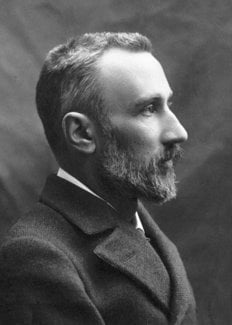Pierre Curie
Biographical

Pierre Curie was born in Paris, where his father was a general medical practitioner, on May 15, 1859. He received his early education at home before entering the Faculty of Sciences at the Sorbonne. He gained his Licenciateship in Physics in 1878 and continued as a demonstrator in the physics laboratory until 1882 when he was placed in charge of all practical work in the Physics and Industrial Chemistry Schools. In 1895 he obtained his Doctor of Science degree and was appointed Professor of Physics. He was promoted to Professor in the Faculty of Sciences in 1900, and in 1904 he became Titular Professor.
In his early studies on crystallography, together with his brother Jacques, Curie discovered piezoelectric effects. Later, he advanced theories of symmetry with regard to certain physical phenomena and turned his attention to magnetism. He showed that the magnetic properties of a given substance change at a certain temperature – this temperature is now known as the Curie point. To assist in his experiments he constructed several delicate pieces of apparatus – balances, electrometers, piezoelectric crystals, etc.
Curie’s studies of radioactive substances were made together with his wife, whom he married in 1895. They were achieved under conditions of much hardship – barely adequate laboratory facilities and under the stress of having to do much teaching in order to earn their livelihood. They announced the discovery of radium and polonium by fractionation of pitchblende in 1898 and later they did much to elucidate the properties of radium and its transformation products. Their work in this era formed the basis for much of the subsequent research in nuclear physics and chemistry. Together they were awarded half of the Nobel Prize for Physics in 1903 on account of their study into the spontaneous radiation discovered by Becquerel, who was awarded the other half of the Prize.
Pierre Curie’s work is recorded in numerous publications in the Comptes Rendus de l’Académie des Sciences, the Journal de Physique and the Annales de Physique et Chimie.
Curie was awarded the Davy Medal of the Royal Society of London in 1903 (jointly with his wife) and in 1905 he was elected to the Academy of Sciences.
His wife was formerly Marie Sklodowska, daughter of a secondary-school teacher at Warsaw, Poland. One daughter, Irene, married Frederic Joliot and they were joint recipients of the Nobel Prize for Chemistry in 1935. The younger daughter, Eve, married the American diplomat H. R. Labouisse. They have both taken lively interest in social problems, and as Director of the United Nations’ Children’s Fund he received on its behalf the Nobel Peace Prize in Oslo in 1965. She is the author of a famous biography of her mother, Madame Curie (Gallimard, Paris, 1938), translated into several languages.
Pierre was killed in a street accident in Paris on April 19, 1906.
This autobiography/biography was written at the time of the award and first published in the book series Les Prix Nobel. It was later edited and republished in Nobel Lectures. To cite this document, always state the source as shown above.
The Nobel Foundation's copyright has expired.Nobel Prizes and laureates
Six prizes were awarded for achievements that have conferred the greatest benefit to humankind. The 14 laureates' work and discoveries range from quantum tunnelling to promoting democratic rights.
See them all presented here.
